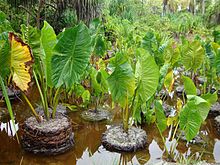
Back Cyrtosperma merkusii CEB Taro géant des marais French Cyrtosperma merkusii Italian Valgomasis strėlenis Lithuanian Cyrtosperma merkusii Portuguese Cyrtosperma merkusii Swedish กลี Thai Babai Tonga Cyrtosperma merkusii Vietnamese Cyrtosperma merkusii WAR
| Cyrtosperma merkusii | |
|---|---|

| |
| Babai cultivation in Butaritari, Kiribati. | |
| Scientific classification | |
| Kingdom: | Plantae |
| Clade: | Tracheophytes |
| Clade: | Angiosperms |
| Clade: | Monocots |
| Order: | Alismatales |
| Family: | Araceae |
| Genus: | Cyrtosperma |
| Species: | C. merkusii
|
| Binomial name | |
| Cyrtosperma merkusii (Hassk.) Schott
| |
| Synonyms | |
| |
Cyrtosperma merkusii or giant swamp taro, is a crop grown throughout Oceania and into South and Southeast Asia. It is a riverine and "swamp crop" similar to taro,[1] but "with bigger leaves and larger, coarser roots."[2] There are no demonstrably wild populations today[citation needed], but it is believed to be native to Indonesia. It is known as puraka in Cook Islands, lak in Yap (Federated States of Micronesia), babai in Kiribati, iaraj in the Marshall Islands, brak in Palau, babaʻ in the Marianas Islands, pula’a in Samoa, via kana, Pulaka in Lau, Lovo in Fiji, pulaka in Tokelau and Tuvalu, mwahng in Pohnpei, pasruk in Kosrae, simiden in Chuuk, swam taro in Papua New Guinea, navia in Vanuatu[3] and palawan in the Philippines.
The same species is also known by the names Cyrtosperma lasioides, Cyrtosperma chamissonis and Cyrtosperma edule.[4]
In the harsh atoll environments of the Central Pacific, especially Tuvalu and Kiribati, swamp taro is an important source of carbohydrates in a diet dominated by fish and coconut. Its cultivation is difficult and time-consuming, and the plant has deep cultural as well as practical significance.[5][6] The roots need to be cooked for hours to reduce toxicity in the corms, but are rich in nutrients, especially calcium.[7] The cultivation of Pulaka in Tuvalu, and babai in Kiribati, is an important cultural and culinary tradition, now under threat from rising sea level and displacement from the growing use of imported food products.
In Nepal, Giant Swamp Taro is called mane and grows in the tropical and sub tropical forests along stream banks. It is gathered in January–February and all plant parts (leaf, stem, rhizomes) are savored after being boiled and roasted. The stem requires prolonged boiling and the water is replaced once to remove irritating chemicals. If cooked carefully, the rhizomes taste like taro and the leaves like spinach. But without careful washing, the food causes an unpleasant tingling or scratchy sensation.[8]
- ^ "Tuvalu could lose root crop". Radio New Zealand. 17 September 2008. Retrieved 10 May 2010.
- ^ "Leaflet No. 1 - Revised 1992 - Taro". Food and Agriculture Organization. Archived from the original on 28 August 2009. Retrieved 10 May 2010.
- ^ "Pacific Food Security Tookit Module 4 - Pacific Root Crops" (PDF). FAO.
- ^ "ITIS report, Cyrtosperma merkusii". Integrated Taxonomic Information System.
- ^ Koch, Gerd (1983–1990). The material culture of Tuvalu. Institute of Pacific Studies, University of the South Pacific. p. 46. Retrieved 12 May 2010.
- ^ Koch, Gerd (1986). The Material Culture of Kiribati. Institute of Pacific Studies, University of the South Pacific. ISBN 978-982-02-0008-1.
- ^ Cite error: The named reference
unwas invoked but never defined (see the help page). - ^ Limbu, Prakash (2012). Nepal Food Culture (PDF). ICIMOD [Kathmandu Nepal]. Archived from the original (PDF) on 2016-03-04. Retrieved 2014-09-18.
© MMXXIII Rich X Search. We shall prevail. All rights reserved. Rich X Search